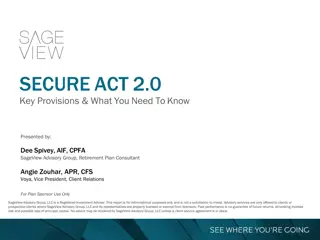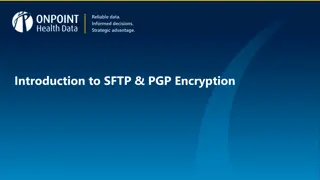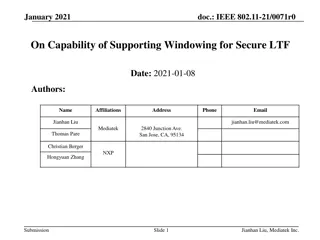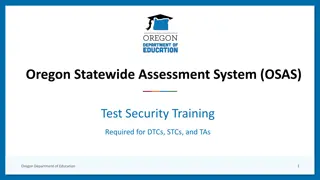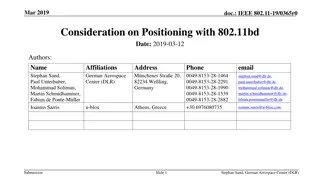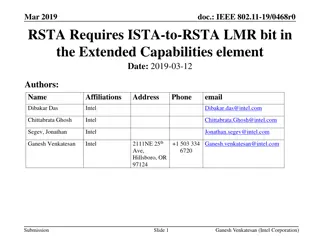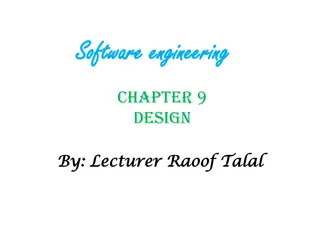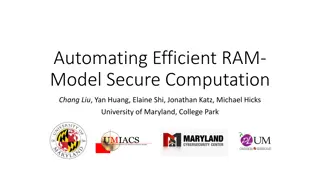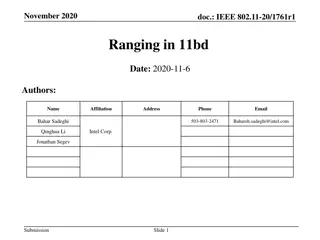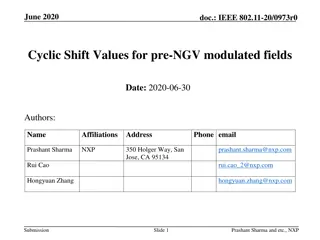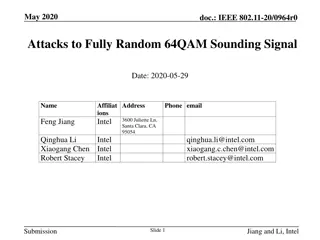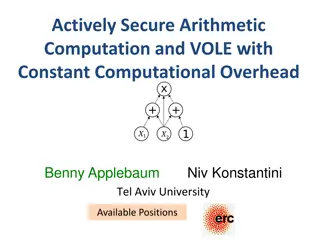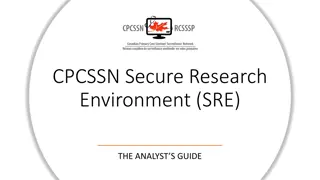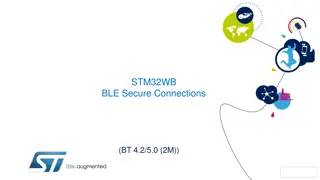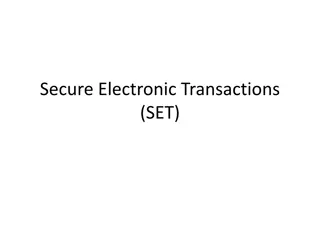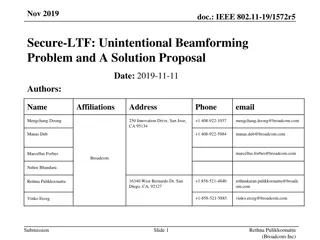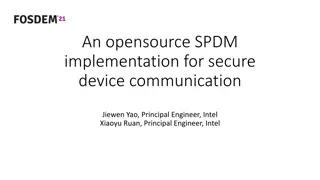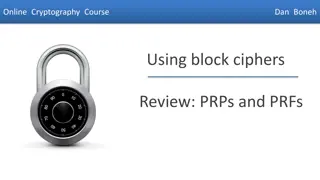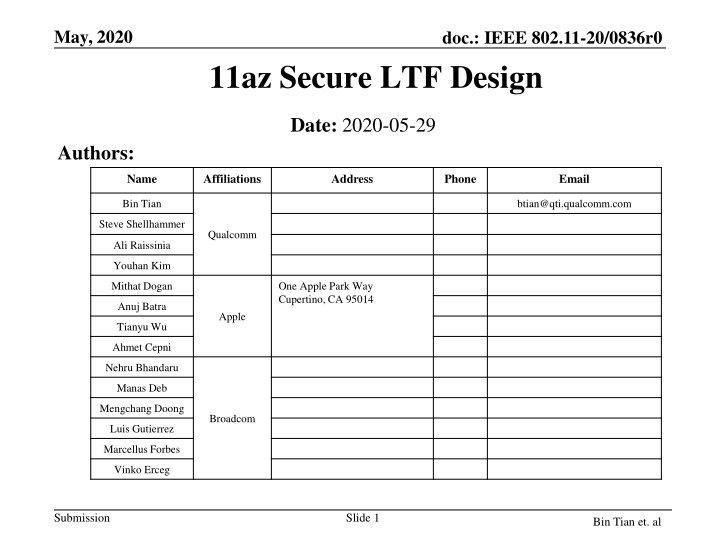
IEEE 802.11-20 Secure LTF Design Overview
"Explore the design and attack models of IEEE 802.11-20 Secure LTF, proposing improvements to enhance security performance through various directions such as signal entropy increase and beamforming mitigation. Discusses modulation schemes, detection algorithms, multi-stream transmission, and more."
Download Presentation

Please find below an Image/Link to download the presentation.
The content on the website is provided AS IS for your information and personal use only. It may not be sold, licensed, or shared on other websites without obtaining consent from the author. If you encounter any issues during the download, it is possible that the publisher has removed the file from their server.
You are allowed to download the files provided on this website for personal or commercial use, subject to the condition that they are used lawfully. All files are the property of their respective owners.
The content on the website is provided AS IS for your information and personal use only. It may not be sold, licensed, or shared on other websites without obtaining consent from the author.
E N D
Presentation Transcript
May, 2020 doc.: IEEE 802.11-20/0836r0 11az Secure LTF Design Date: 2020-05-29 Authors: Name Affiliations Address Phone Email Bin Tian btian@qti.qualcomm.com Steve Shellhammer Qualcomm Ali Raissinia Youhan Kim Mithat Dogan One Apple Park Way Cupertino, CA 95014 Anuj Batra Apple Tianyu Wu Ahmet Cepni Nehru Bhandaru Manas Deb Mengchang Doong Broadcom Luis Gutierrez Marcellus Forbes Vinko Erceg Submission Slide 1 Bin Tian et. al
May, 2020 doc.: IEEE 802.11-20/0836r0 Authors (continued): Name Affiliations Address Phone Email Erik Lindskog Srinivas Kandala Samsung Wook Bong Lee Ashok Ranganath Stuart Walker Strickland HPE Jerome Henry Cisco HanGyu Cho LGE Sang Gook Kim Roy Want Google Mingguang Xu Christian Berger NXP Manish Kumar Submission Slide 2 Bin Tian et. al
May, 2020 doc.: IEEE 802.11-20/0836r0 11az LB249 CID 3911 CID Page/Line Clause Comment Proposed resolution 3911 153.00 11.22.6.4.6 The Secure LTF mechanism for TB and NTB ranging needs to be improved. A submission will be provided. As in comment. Submission Slide 3 Bin Tian et. al
May, 2020 doc.: IEEE 802.11-20/0836r0 Overview 11az secure LTF design and attack models have been discussed in many contributions (e.g. [1]-[6]) Improvements to secure LTF design can be considered in following directions Increase PHY signal entropy to deter attack [2] Mitigate unintentional beamforming [4] In current multi-stream design all antennas transmit the same signal Relieve MAC/PHY interface burden from passing large number of bits Increasing PHY signal entropy requires large number of pseudo-random bits Maintain PAPR no worse than normal data portion Keep other aspects of existing secure LTF design E.g. zero GI, 2x LTF, LTF repetition, no pilots, etc. Submission Slide 4 Bin Tian et. al
May, 2020 doc.: IEEE 802.11-20/0836r0 Outline Security performance analysis of secure LTF modulation scheme Single tone (slicer) detection Sequential detection using Viterbi algorithm Multi-stream transmission PAPR analysis Pseudo-random Generator Summary of our proposals Submission Slide 5 Bin Tian et. al
May, 2020 doc.: IEEE 802.11-20/0836r0 Introduction Secure LTF OFDM Symbol Attack Period Observation Period Computation Period Parameters Observation period Tob, Computation period Tc and Attack period Tatk, are all normalized by the OFDM symbol duration. Some attacker capability discussions are given in [1]. Worst case: Tc= 0 is used for in this study. For Tc>0 cases, Tatk will be smaller which lead to less attacker effectiveness. Metric of attack effectiveness Attacker frequency domain estimation bit error rate : indirect metric Time domain cross-correlation coefficient, Corr, between secure LTF signal and the estimated (attack) signal during the attack period [6]. Attack success rate depends on time domain correlation during the attack period and the duration of the attack period. Longer attack period and higher correlation in the attack period will lead to higher attack success rate. Submission Slide 6 Bin Tian et. al
May, 2020 doc.: IEEE 802.11-20/0836r0 PER TONE (SLICING) ATTACK Submission Slide 7 Bin Tian et. al
May, 2020 doc.: IEEE 802.11-20/0836r0 Per Tone (Slicing) Attack Attacker processes each tone to estimate original signal[1][3] Secure LTF: per tone secure pseudo random sequence. The following analysis focus on attacker effectiveness with different modulation levels for secure LTF. Signal model ?1 ?2 ?2 ?1 ?2 ?1 = ? + Assumption for the attacker AWGN channel, known channel phase Modulation knowledge (e.g. QPSK, ) Estimation based on partial observation during the observation Zero pad the observed signal to entire symbol then do FFT Use slicer to estimate original signal Computation cost is minimal. Submission Slide 8 Bin Tian et. al
May, 2020 doc.: IEEE 802.11-20/0836r0 BER and Corr: Tob=5/8, Tatk=3/8 CDF of correlation coefficient of attacker signal with true signal Attacker detection bit error rate CDF. SNR=30dB, Norm. Observeration Period= 0.625. CDF of correlation of attack sigal with original signal. SNR=30dB, Norm. Attack Period 0.375. 1 1 256QAM(976bits) 64QAM(732bits) 16QAM(488bits) 8PSK(366bits) QPSK(244bits) 0.9 0.9 0.8 0.8 0.7 0.7 0.6 0.6 CDF CDF 0.5 0.5 0.4 0.4 256QAM(976bits) 64QAM(732bits) 16QAM(488bits) 8PSK(366bits) QPSK(244bits) AWGN 0.3 0.3 0.2 0.2 0.1 0.1 0 0 0 0.1 0.2 0.3 0.4 0.5 0.6 0.7 0.8 0.9 1 0 0.1 0.2 0.3 0.4 0.5 0.6 0.7 0.8 0.9 1 Bit error rate Absolute value of correlation coefficient (Computed over attack period) BER increases as modulation order QAM signal achieves similar correlation performance (at 95% tail) About half of QPSK correlation coefficient About double of the optimal case of using time domain Gaussian random signal Submission Slide 9 Bin Tian et. al
May, 2020 doc.: IEEE 802.11-20/0836r0 An Example of Attack in AWGN channel Frequency response after decovering using securing bits. SINR=1.0916dB Attack signal relative power 3.2138dB, corr=0.58248 Channel time response. Attack signal relative power 3.2138dB. corr=0.58248 Amplitude of the orignal receive signal and attack signal 0 0.35 10 Original Attack Path Original signal Attack signal Original Attack -10 0.3 5 -20 0 0.25 -5 -30 0.2 Amplitude dB -10 dB 0.15 -40 -15 0.1 -50 -20 0.05 -60 -25 0 -70 -30 0 20 40 60 Time(Cx1) 80 100 120 140 0 20 40 60 Time (Cx1) 80 100 120 140 0 20 40 60 tone index 80 100 120 140 20MHz QPSK received with SNR = 30 dB After Tob=5/8 , an attack signal with corr = 0.58 is received during Tatk=3/8 To generate a false peak with FP = -10dB from signal path, during attack period the attack signal power must be 20*log10(Tatk corr) +FP = 3.21dB higher than original signal This reduces SINR at the receiver to around 1.1 dB. SIR reduction effects of an attack are detailed next. Slide 10 Submission Source sample text Bin Tian et. al
May, 2020 doc.: IEEE 802.11-20/0836r0 Big Picture: Attack Leads to SIR Drop Receive SIR after attack 15 To create a false peak with relative power level of FP (e.g. FP= -10dB for the right plot), an attack signal will cause interference at the intended receiver. As proved in the Appendix, SIR at the receiver is given as : 10 5 0 SIR(dB) -5 -10 Tatk=0.125 Tatk=0.25 Tatk=0.375 Tatk=0.5 ??? ?? = 10???10???? +20???10???? 10???101 ????????2 ??(??) Attack causes SIR drop at the receiver. The lower correlation or the shorter attack period or the higher target relative power of false peak (FP), the lower SIR after attack. -15 -20 0.1 0.2 0.3 0.4 0.5 0.6 0.7 0.8 0.9 1 Absolute corr of attack signal and original signal during attack period 95% Corr range for Tatk=3/8 and Tob=5/8 Time Domain random : <=0.25 All QAMs: <=0.4 :QPSK: <= 0.7 Submission Source sample text Slide 11 Bin Tian et. al
May, 2020 doc.: IEEE 802.11-20/0836r0 SIR with different FP Expected Value of SIR as a function of , FP = -15 dB 40 Golay Attack [3] 30 20 10 Expected SIR (dB) 0 Tatk = 0.125 Tatk = 0.25 Tatk = 0.375 Tatk = 0.5 Tatk = 0.625 Tatk = 0.75 Tatk = 0.875 Tatk = 0.97 -10 -20 -30 -40 0 0.1 0.2 0.3 0.4 0.5 0.6 0.7 0.8 0.9 1 : Cross-Correlation Coefficient SIR curves move opposite direction to changes in FP for FP = -15dB, curves move up by 5dB comparing to FP=-10dB case. Submission Slide 12 Bin Tian et. al
May, 2020 doc.: IEEE 802.11-20/0836r0 Attack Detection Simulation Attack detection can be performed by checking SINR Up to implementation. One simple SINR estimator can utilize the repeated secure LTF. After removing the secure modulated symbols, the difference between the residuals from two symbols can be treated as interference plus noise Simulation estimated SINR matches the expression: ??? ?? = 10???10???? +20???10???? 10???101 ????????2 ??(??) Attack can be identified by comparing the estimated SINR against a threshold. Attack detection against Golay is not possible due to high SIR after attack. CDF of Attack Detector Estimated SINR. Target false peak -10dB. SNR=30dB, Atteck Period= 0.375. Observe Period=0.625. SNR = 30 dB, Attack Period = 0.375, Observe Period = 0.625 1 0.9 0.8 0.7 0.6 CDF 0.5 0.4 0.3 0.2 QPSK(244bits) 16QAM(488bits) Ideal Attack 0.1 -8 -6 -4 -2 0 2 4 6 8 SINR (dB) 16/64/256 QAM: secure. Similar correlation. Attack leads to <0dB SINR which can be easily detected QPSK: marginally secure. Attack leads to <5dB SNR. Ideal attack (assuming attack knows the signal perfectly (100% corr) after the observation period). Submission Slide 13 Bin Tian et. al
May, 2020 doc.: IEEE 802.11-20/0836r0 Remarks on Results of Per-Tone Estimation Attack Security of LTF is not just about whether an attacker can recover the sequence Delay attacker from generating a correlated attack signal Shrink potential attack duration to make attack more detectable If attacker uses per-tone processing, 16QAM and above QAM modulation based LTF is secure Potential attack signal correlation is relatively small. Partially correlated, part-time attack signal forces SINR below 0 dB at the receiver, which makes the attack easily detectable. Submission Slide 14 Bin Tian et. al
May, 2020 doc.: IEEE 802.11-20/0836r0 SEQUENTIAL DETECTION BASED ATTACK VIA VITERBI ALGORITHM Submission Slide 15 Bin Tian et. al
May, 2020 doc.: IEEE 802.11-20/0836r0 Overview In the past analysis, we have shown that 16QAM is secure enough if attacker employs per tone slicing. The question remains what if the attacker using sequential detection scheme Brute force ML is computational prohibitive given the short duration of LTF symbol and amount of entropy from PHY signal Viterbi scheme is more computationally efficient and its performance close to ML. In this analysis we study the performance when Viterbi scheme is used Submission Slide 16 Bin Tian et. al
May, 2020 doc.: IEEE 802.11-20/0836r0 Viterbi Equalizer The Viterbi equalizer approach is described in [3, 6] Apply windowing in the time domain over the observation period. Prefer Hamming window to reduce the equalizer tap in frequency domain Time domain windowing is equivalent to frequency domain convolution which leads to ICI Viterbi equalizer can be used to solve this problem optimally Performance depends on the number of filter taps to be modeled in Viterbi equalizer Computational cost mainly depends on the number of states in Viterbi, K. K= 2^(bit per symbol * (tap-1)) For 16QAM, K= 256 and 64k for tap 3 and 5 filter For 64QAM, K= 4k and 16M for tap 3 and 5 filter Number of states and metric computations are illustrated next. Submission Slide 17 Bin Tian et. al
May, 2020 doc.: IEEE 802.11-20/0836r0 Frequency response due to partial observation and filtering Frequency responses as function of partial observation duration in dB Choose a threshold to determine number of taps to include in Viterbi decoder and number of states. Threshold 1 Threshold 2 Observation Percentage (M/N) Lower threshold is required (more taps) for success of MLSE for higher order of modulation To capture taps >-20dB, needs to have 7 taps for Viterbi when observation period=1/2 M: number of observation samples N: number of total samples in OFDM symbol Tap Index (One side shown due to symmetry) Submission Slide 18 Bin Tian et. al
May, 2020 doc.: IEEE 802.11-20/0836r0 Number of Viterbi states vs. Partial Observation Log2(Viterbi States) as a function of (M /N), Thresh = -20 dB Figure shows: 150 QPSK 16-QAM 64-QAM 256-QAM Accommodate taps that are within -20 dB of maximum 100 log2(#States) 50 Metric calculations only for one-round on trellis M: number of observation samples N: number of total samples in OFDM symbol Does not include retracing, comparison, elimination 0 0 0.1 0.2 0.3 0.4 0.5 0.6 0.7 Observation Percentage (M/N) Submission Slide 19 Bin Tian et. al
May, 2020 doc.: IEEE 802.11-20/0836r0 16QAM with Viterbi Equalizer (64K States, 5 Taps) BER and Corr: Tob = 1/2 CDF of Bit Error Rate at Attacker after partial observation CDF of correlation coefficient of attacker signal with true signal Attacker detection bit error rate CDF. Optimized rotation SNR=30dB, Norm. Observeration Period= 0.5. SNR = 30 dB, Norm. Observation Period = 0.5 CDF of correlation of attack sigal with real signal. Optimized rotation SNR=30dB, Norm. attack sig duration 0.5. SNR = 30 dB, Norm. Attack Period = 0.5 1 1 16QAM 16QAM AWGN(TD) 0.9 0.9 0.8 0.8 0.7 0.7 0.6 0.6 CDF 0.5 CDF 0.5 0.4 0.4 0.3 0.3 0.2 0.2 0.1 0.1 0 0 0 0.1 0.2 0.3 0.4 0.5 0.6 0.7 0.8 0.9 1 0 0.1 0.2 0.3 0.4 0.5 0.6 0.7 0.8 0.9 1 Bit error rate Absolute corr between attack and original signal during attack period 5-tap Viterbi can not recover the signal, with observation period of 1/2 Attack performance is worse than per-tone (slicer) based approach Submission Slide 20 Bin Tian et. al
May, 2020 doc.: IEEE 802.11-20/0836r0 16QAM with Viterbi Equalizer (64K States, 5 Taps) BER and Corr: Tob = 9/16 CDF of correlation coefficient of attacker signal with true signal CDF of Bit Error Rate at Attacker after partial observation CDF of correlation of attack sigal with real signal. Optimized rotation SNR=30dB, Norm. attack sig duration 0.4375. SNR = 30 dB, Norm. Attack Period = 0.4375 Attacker detection bit error rate CDF. Optimized rotation SNR=30dB, Norm. Observeration Period= 0.5625. SNR = 30 dB, Norm. Observation Period = 0.5625 1 1 16QAM AWGN(TD) 16QAM 0.9 0.9 0.8 0.8 0.7 0.7 0.6 0.6 CDF 0.5 CDF 0.5 0.4 0.4 0.3 0.3 0.2 0.2 0.1 0.1 0 0 0 0.1 0.2 0.3 0.4 0.5 0.6 0.7 0.8 0.9 1 0 0.1 0.2 0.3 0.4 0.5 0.6 0.7 0.8 0.9 1 Absolute corr between attack and original signal during attack period Bit error rate When observation duration gets longer, like 6/19, Viterbi equalizer starts to show better performance and generate highly correlated (>0.9) attack signal Submission Slide 21 Bin Tian et. al
May, 2020 doc.: IEEE 802.11-20/0836r0 16QAM with Viterbi Equalizer (256 States, 3 Taps) BER and Corr: Tob = 9/16 CDF of Bit Error Rate at Attacker after partial observation CDF of correlation coefficient of attacker signal with true signal Attacker detection bit error rate CDF. Optimized rotation SNR=30dB, Norm. Observeration Period= 0.5625. SNR = 30 dB, Norm. Observation Period = 0.5625 CDF of correlation of attack sigal with real signal. Optimized rotation SNR=30dB, Norm. attack sig duration 0.4375. SNR = 30 dB, Norm. Attack Period = 0.4375 1 1 16QAM 16QAM AWGN(TD) 0.9 0.9 0.8 0.8 0.7 0.7 0.6 0.6 CDF CDF 0.5 0.5 0.4 0.4 0.3 0.3 0.2 0.2 0.1 0.1 0 0 0 0.2 0.4 0.6 0.8 1 0 0.1 0.2 0.3 0.4 0.5 0.6 0.7 0.8 0.9 1 Absolute correlation coefficient between attack and original signal during attack period Bit error rate For 256-State Viterbi, even 9/16 observation period is not sufficient to generate highly correlated attack signal Performance is even worse than per-tone (slicing) approach Submission Slide 22 Bin Tian et. al
May, 2020 doc.: IEEE 802.11-20/0836r0 16QAM with Viterbi Equalizer (256 States, 3 Taps) BER and Corr: Tob = 3/4 CDF of Bit Error Rate at Attacker after partial observation CDF of correlation coefficient of attacker signal with true signal CDF of correlation of attack sigal with real signal. Optimized rotation SNR=30dB, Norm. attack sig duration 0.25. SNR = 30 dB, Norm. Attack Period = 0.25 Attacker detection bit error rate CDF. Optimized rotation SNR=30dB, Norm. Observeration Period= 0.75. SNR = 30 dB, Norm. Observation Period = 0.75 1 1 16QAM AWGN(TD) 16QAM 0.9 0.9 0.8 0.8 0.7 0.7 0.6 0.6 CDF CDF 0.5 0.5 0.4 0.4 0.3 0.3 0.2 0.2 0.1 0.1 0 0 0 0.1 0.2 0.3 0.4 0.5 0.6 0.7 0.8 0.9 1 0 0.1 0.2 0.3 0.4 0.5 0.6 0.7 0.8 0.9 1 Absolute corr between attack and original signal during attack period Bit error rate 256-State Viterbi equalizer needs long observation period (e.g. ) to generate highly correlated attack signal Submission Slide 23 Bin Tian et. al
May, 2020 64QAM Viterbi Equalizer (4096 States, 3 Taps) Tob = 3/4 doc.: IEEE 802.11-20/0836r0 CDF of correlation coefficient of attacker signal with true signal CDF of correlation of attack sigal with real signal. Optimized rotation SNR=30dB, Norm. attack sig duration 0.25. SNR = 30 dB, Norm. Attack Period = 0.25 1 64QAM AWGN(TD) 0.9 0.8 0.7 0.6 CDF 0.5 0.4 0.3 0.2 0.1 0 0 0.1 0.2 0.3 0.4 0.5 0.6 0.7 0.8 0.9 1 Absolute corr between attack and original signal during attack period If secure LTF is using 64QAM, despite a large observation period of 3/4, attacker can not generate highly correlated attack signal using 3 tap Viterbi algorithm. Submission Slide 24 Bin Tian et. al
May, 2020 doc.: IEEE 802.11-20/0836r0 256QAM Viterbi Equalizer (64k States, 3 Taps) Tob = 3/4 CDF of Bit Error Rate at Attacker after partial observation CDF of correlation coefficient of attacker signal with true signal Attacker detection bit error rate CDF. Optimized rotation SNR=30dB, Norm. Observeration Period= 0.75. SNR = 30 dB, Norm. Observation Period = 0.75 CDF of correlation of attack sigal with real signal. Optimized rotation SNR=30dB, Norm. attack sig duration 0.25. SNR = 30 dB, Norm. Attack Period = 0.25 1 1 256QAM(ATK256QAM) 256QAM(ATK256QAM) AWGN(TD) 0.9 0.9 0.8 0.8 0.7 0.7 0.6 0.6 CDF CDF 0.5 0.5 0.4 0.4 0.3 0.3 0.2 0.2 0.1 0.1 0 0 0 0.2 0.4 0.6 0.8 1 0 0.1 0.2 0.3 0.4 0.5 0.6 0.7 0.8 0.9 1 Bit error rate Absoluttion value of the correlation between attack signal and partial real signal For 256QAM modulated LTF, even after observation period of 3/4 the attacker still can not generate high correlation signal using 3 tap Viterbi algorithm 5 Tap Viterbi requires 4G states! Submission Slide 25 Bin Tian et. al
May, 2020 Remarks on Sequence Detection Results doc.: IEEE 802.11-20/0836r0 16QAM: marginally secure 5 Tap, 64k state Viterbi equalizer can generate a highly correlated attack signal after observation period of 9/16 64 QAM or equivalent entropy: secure 3 Tap, 4096 state Viterbi equalizer can NOT generate a highly correlated attack signal even after observation period of 3/4 5 Tap filter requires 16M state Viterbi. Even with millions of states, still requires significant observation period 256 QAM or equivalent entropy: very secure 3 Tap, 64k state Viterbi equalizer can NOT generate highly correlated attack signal even after observation period of 3/4 5 Tap Viterbi requires 4G (2^32) states Our recommendation: 64 QAM Balance the security, complexity and ranging performance Submission Slide 26 Bin Tian et. al
May, 2020 doc.: IEEE 802.11-20/0836r0 MULTI-STREAM SIGNAL CASE Submission Slide 27 Bin Tian et. al
May, 2020 doc.: IEEE 802.11-20/0836r0 Introduction In previous sections, we discussed the security performance of different modulations for secure LTF. Those results were for the single stream case Assuming the worst-case scenario: attacker achieves AWGN channel from the transmitter Now, we want to expand the analysis to multi-stream case: Assume the worst-case scenario: attacker achieves AWGN channel for each TX antenna. It can receive each stream signal separately with degradation from only AWGN noise It can combine the observations from all the streams in computation To mitigate unintentional beamforming, we might consider introducing per stream phase rotation Submission Slide 28 Bin Tian et. al
May, 2020 doc.: IEEE 802.11-20/0836r0 Case I per SS Fixed Phase Rotation (1ss vs 4ss) CDF of correlation coefficient of attacker signal with true signal (fixed phase) CDF of Bit Error Rate at Attacker (fixed phase) Attacker detection bit error rate CDF. No phase rotation SNR=100dB, Norm. Observeration Period= 0.625. SNR = 100 dB, Norm. Observation Period = 0.625 CDF of correlation of attack sigal with real signal. No phase rotation SNR=100dB, Norm. attack sig duration 0.375. SNR = 100 dB, Norm. Attack Period = 0.375 1 1 0.9 0.9 0.8 0.8 0.7 0.7 0.6 0.6 CDF CDF 0.5 0.5 0.4 0.4 16QAM(1ss) 64QAM(1ss) 256QAM(1ss) 16QAM(4ss) 64QAM(4ss) 256QAM(4ss) 16QAM(1ss) 64QAM(1ss) 256QAM(1ss) 16QAM(4ss) 64QAM(4ss) 256QAM(4ss) 0.3 0.3 0.2 0.2 0.1 0.1 0 0 0 0.1 0.2 0.3 0.4 0.5 0.6 0.7 0.8 0.9 1 0 0.1 0.2 0.3 0.4 0.5 0.6 0.7 0.8 0.9 1 Bit error rate Absolute corr between attack and original signal during attack period When each stream applies fixed phase rotation to all the tones, attacker can not gain much from combining multi-streams ICI is dominant but ICI is the same across different streams so it can not be averaged. However, per SS fixed phase rotation causes unintentional beamforming at certain direction Submission Slide 29 Bin Tian et. al
May, 2020 Case II per SS Pseudo-random Phase Rotation (1ss vs 4ss) doc.: IEEE 802.11-20/0836r0 CDF of Bit Error Rate at Attacker (random phase rotation) CDF of correlation coefficient of attack signal with true (random phase rotation) Attacker detection bit error rate CDF. Random phase rotation SNR=100dB, Norm. Observeration Period= 0.625. SNR = 100 dB, Norm. Observation Period = 0.625 CDF of correlation of attack sigal with real signal. Random phase rotation SNR=100dB, Norm. attack sig duration 0.375. SNR = 100 dB, Norm. Attack Period = 0.375 1 1 0.9 0.9 0.8 0.8 0.7 0.7 0.6 0.6 CDF CDF 0.5 0.5 0.4 0.4 16QAM(1ss) 64QAM(1ss) 256QAM(1ss) 16QAM(4ss) 64QAM(4ss) 256QAM(4ss) 16QAM(1ss) 64QAM(1ss) 256QAM(1ss) 16QAM(4ss) 64QAM(4ss) 256QAM(4ss) 0.3 0.3 0.2 0.2 0.1 0.1 0 0 0 0.1 0.2 0.3 0.4 0.5 0.6 0.7 0.8 0.9 1 0 0.1 0.2 0.3 0.4 0.5 0.6 0.7 0.8 0.9 1 Bit error rate Absolute corr between attack and original signal during attack period When each stream applies pseudo-random phase rotation on each tone, it provides ICI diversity to attacker Cross correlation between attack signal and signal >0.8 for QAM Different phase rotation causes ICI variation among different streams and provides combining gain to reduce ICI. Slide 30 Submission Bin Tian et. al
May, 2020 doc.: IEEE 802.11-20/0836r0 Discussion Per tone randomized per stream phase rotation provides ICI diversity to attacker and introduces a security vulnerability Per stream phase rotation must be constant for all the tones in all the LTF symbols within a repetition We propose time diversity from secure LTF repetitions to mitigate unintentional BF issue: For reach repetition, apply the same beamforming direction on all the tones Beamforming direction changes per repetition such that any negative impact from unintentional BF doesn t persist across repetitions Submission Slide 31 Bin Tian et. al
May, 2020 doc.: IEEE 802.11-20/0836r0 Proposals on Multi-Stream Signal Generation Just like in baseline 11ax, apply per-stream CSD to HE-STF such that AGC can be set properly For multiple stream secure LTF, no CSD but with per stream phase rotation updated per repetition Generate phase rotation angle set for M total spatial streams: ????, ???? Phase rotation angle is generated using the pseudo-random bit sequence The same set of per stream phase rotation is applied to all the tones in all the LTF symbols in one repetition Since all the tones are applied with the same per stream phase rotation, there is No ICI diversity among different streams for attacker Update the per stream phase rotation angle set for every repetition Any negative impact from unintentional BF does not propagate to next repetition Submission Slide 32 Bin Tian et. al
May, 2020 Multi-stream LTF Generation: Equations doc.: IEEE 802.11-20/0836r0 The (per-tone) operation can be written as, ? = ? ? ? where ? and ? are diagonal matrices ?? ? ? ? ? ? ? ?? ???? ? ? ? ? ? ? ? = ? = ???? ? matrix is already defined in spec L is the matrix for secure LTF sequence. o It must be diagonal to ensure full rank and simple channel estimation o The diagonal elements of L are generated from secure bits. N is the number of HE LTFs o The diagonal elements of L change per tone per LTF symbol but are the same for all the streams ? is per stream phase rotation matrix. o For the m-th stream, ??, is the same for all the tones in each LTF within a repetition and changes per LTF repetition. M is the number of spatial streams Submission Slide 33 Bin Tian et. al
May, 2020 doc.: IEEE 802.11-20/0836r0 Multi Stream Secure LTF Generation X Secure PN Sequence Secure 64QAM Modulator X PN Generator P Matrix 6 X Per Stream Phase Rotation Per stream phase rotation angle is the same for all the tones and all the LTFs in one repetition, and updated every repetition Submission Slide 34 Bin Tian et. al
May, 2020 doc.: IEEE 802.11-20/0836r0 PAPR ANALYSIS Submission Slide 35 Bin Tian et. al
May, 2020 doc.: IEEE 802.11-20/0836r0 PAPR Pseudo Random 64-QAM PAPR for pseudo-random 64QAM is the same as pseudo-random QPSK Submission Slide 36 Bin Tian et. al
May, 2020 doc.: IEEE 802.11-20/0836r0 PN PSEUDO-RANDOM GENERATOR Submission Slide 37 Bin Tian et. al
May, 2020 doc.: IEEE 802.11-20/0836r0 Secure PN Generator Need for Secure PN Generator It is necessary to add a Secure PN Generator to PHY Layer since the number of bits required exceeded the capacity of the MAC/PHY control interface in many implementations Choice of Secure PN Generator Here, we propose use of the AES-128 Counter Mode (AES- 128 CTR) block cipher to generate the Secure PN bit needed to construct the Secure LTF sequences AES-128 CTR has been approved by NIST and is widely considered very secure AES is familiar to IEEE 802.11 engineers since it is used for MAC layer security Submission Slide 38 Bin Tian et. al
May, 2020 doc.: IEEE 802.11-20/0836r0 Secure PN Generation Submission Slide 39 Bin Tian et. al
May, 2020 doc.: IEEE 802.11-20/0836r0 Secure PN Generator AES-128 Counter Mode Operation AES-128 is reinitialized at the beginning of each Secure NDP The 128-bit Key and the 128-bit Initiation Vector are provided by the MAC Layer at the beginning of the NDP The MAC uses the Key Derivation Function (KDF) to generate the 128-bit Key and 128-bit Initialization Vector So the MAC provides 256 bits over MAC/PHY Control Interface The AES engine provides all the required PN bits for the entire NDP before reinitialization at the beginning of the next NDP This applies to all bandwidths (20/40/80/160 MHz) Submission Slide 40 Bin Tian et. al
May, 2020 doc.: IEEE 802.11-20/0836r0 Number of Pseudo-random Bits Required For one secure LTF symbol Bandwid th (MHz) Number of Non-Zero Tones Number of Secure Bits for One Secure LTF (8PSK with Golay Structure) Number of Secure Bits Needed for One Secure LTF (QPSK Modulation) Number of Secure Bits Needed for One Secure LTF (16-QAM Modulation) Number of Secure Bits Needed for One Secure LTF (64-QAM Modulation) 20 122 31 244 488 732 40 242 35 484 968 1452 80 498 39 996 1992 2988 160 996 43 1992 3984 5976 For entire NDP, the needed pseudo-random bits = per LTF bits x Number of secure LTFs Max number of secure LTF is 64 Submission Slide 41 Bin Tian et. al
May, 2020 doc.: IEEE 802.11-20/0836r0 SUMMARY OF PROPOSAL Submission Slide 42 Bin Tian et. al
May, 2020 doc.: IEEE 802.11-20/0836r0 Proposals on 11az Secure LTF Changes Secure PN Generation at PHY using AES-128 CTR New modulation to increase signal entropy 64QAM Per stream phase rotation updated every secure LTF repetition Per stream phase rotation angles are the same for all the tones and all the LTFs in one repetition Submission Slide 43 Bin Tian et. al
May, 2020 doc.: IEEE 802.11-20/0836r0 SP 1 Do you agree to replace the existing 11az secure LTF design parameters with the following changes Using secure pseudo random 64QAM modulation A single secure LTF value is used across all streams for a single tone Using AES-128 CTR as pseudo random bit generator for sounding NDP sequence A 256-bit sequence from KDF is used to initialize AES128-CTR by using 1st 128 bits as the Key and 2nd 128 bits as IV Using per stream phase rotation which is updated every secure LTF repetition Per stream phase rotation angles are the same for all the tones and all the LTFs in one repetition Y/N/ABS Submission Slide 44 Bin Tian et. al
May, 2020 doc.: IEEE 802.11-20/0836r0 References [1] 802.11-20/0374r0 Computational Attacks on 11az PHY Secure Ranging [2] 802.11-20/0375r1 Improved Secure LTF [3] 802.11-20/0381r1 On Brute Force Attack to 11az Secure mode [4] 802.11-19/1572r5 Secure LTF: Unintentional Beamforming problem and a Solution Proposal [5] 802.11-20/0378r0 Secure LTF Attack Simulation [6] 802.11-20/0710r1 Attacks to Fully Random QPSK Sounding Signal Submission Slide 45 Bin Tian et. al
May, 2020 doc.: IEEE 802.11-20/0836r0 APPENDIX Submission Slide 46 Bin Tian et. al
May, 2020 doc.: IEEE 802.11-20/0836r0 BER and Corr: Tob = 3/8, Tatk = 5/8 CDF of Bit Error Rate at Attacker Attacker detection bit error rate CDF. SNR=30dB, Norm. Observeration Period= 0.375. SNR = 30 dB, Norm. Observation Period = 0.375 CDF of correlation coefficient of attacker signal with true signal CDF of correlation of attack sigal with original signal. SNR=30dB, Norm. Attack Period 0.625. SNR = 30 dB, Norm. Attack Period = 0.625 1 1 256QAM(976bits) 64QAM(732bits) 16QAM(488bits) 8PSK(366bits) QPSK(244bits) 0.9 0.9 0.8 0.8 0.7 0.7 0.6 0.6 CDF 0.5 CDF 0.5 0.4 0.4 256QAM(976bits) 64QAM(732bits) 16QAM(488bits) 8PSK(366bits) QPSK(244bits) AWGN 0.3 0.3 0.2 0.2 0.1 0.1 0 0 0 0.1 0.2 0.3 0.4 0.5 0.6 0.7 0.8 0.9 1 0 0.1 0.2 0.3 0.4 0.5 0.6 0.7 0.8 0.9 1 Bit error rate Absolute value of correlation coefficient (Computed over attack period) Not much difference among different modulation orders All close to time domain pseudo-random Gaussian waveform Submission Slide 47 Bin Tian et. al
May, 2020 doc.: IEEE 802.11-20/0836r0 BER and Corr: Tob = 1/2, Tatk = 1/2 CDF of Bit Error Rate at Attacker CDF of correlation coefficient of attacker signal with true signal Attacker detection bit error rate CDF. SNR=30dB, Norm. Observeration Period= 0.5. SNR = 30 dB, Norm. Observation Period = 0.5 CDF of correlation of attack sigal with original signal. SNR=30dB, Norm. Attack Period 0.5. SNR = 30 dB, Norm. Attack Period = 0.5 1 1 256QAM(976bits) 64QAM(732bits) 16QAM(488bits) 8PSK(366bits) QPSK(244bits) 0.9 0.9 0.8 0.8 0.7 0.7 0.6 0.6 CDF CDF 0.5 0.5 0.4 0.4 256QAM(976bits) 64QAM(732bits) 16QAM(488bits) 8PSK(366bits) QPSK(244bits) AWGN 0.3 0.3 0.2 0.2 0.1 0.1 0 0 0 0.1 0.2 0.3 0.4 0.5 0.6 0.7 0.8 0.9 1 0 0.1 0.2 0.3 0.4 0.5 0.6 0.7 0.8 0.9 1 Bit error rate Absolute value of correlation coefficient (Computed over attack period) Submission Slide 48 Bin Tian et. al
May, 2020 doc.: IEEE 802.11-20/0836r0 BER and Corr: Tob = 3/4, Tatk = 1/4 CDF of Bit Error Rate at Attacker CDF of correlation coefficient of attacker signal with true signal CDF of correlation of attack sigal with original signal. SNR=30dB, Norm. Attack Period 0.25. SNR = 30 dB, Norm. Attack Period = 0.25 Attacker detection bit error rate CDF. SNR=30dB, Norm. Observeration Period= 0.75. SNR = 30 dB, Norm. Observation Period = 0.75 1 1 256QAM(976bits) 64QAM(732bits) 16QAM(488bits) 8PSK(366bits) QPSK(244bits) 0.9 0.9 0.8 0.8 0.7 0.7 0.6 0.6 CDF CDF 0.5 0.5 0.4 0.4 256QAM(976bits) 64QAM(732bits) 16QAM(488bits) 8PSK(366bits) QPSK(244bits) AWGN 0.3 0.3 0.2 0.2 0.1 0.1 0 0 0 0.1 0.2 0.3 0.4 0.5 0.6 0.7 0.8 0.9 1 0 0.1 0.2 0.3 0.4 0.5 0.6 0.7 0.8 0.9 1 Bit error rate Absolute value of correlation coefficient (Computed over attack period) Submission Slide 49 Bin Tian et. al
May, 2020 doc.: IEEE 802.11-20/0836r0 If Viterbi Equalizer uses a lower order modulation to approximate signal (64k States, Tap 5) Tob = 3/4 CDF of correlation of attack sigal with real signal. Optimized rotation SNR=30dB, Norm. attack sig duration 0.25. SNR = 30 dB, Norm. Attack Period = 0.25 CDF of correlation coefficient of attacker signal with true signal 1 64QAM(ATK16QAM) 256QAM(ATK16QAM) 0.9 0.8 0.7 0.6 CDF 0.5 0.4 0.3 0.2 0.1 0 0 0.1 0.2 0.3 0.4 0.5 0.6 0.7 0.8 0.9 1 Absoluttion value of the correlation between attack signal and partial real signal (Computed over attack period) If LTF using 64QAM or 256QAM while attacker using 16QAM in equalizer to approximate the signal, the attack signal correlation is small every for Tob = 3/4 Submission Slide 50 Bin Tian et. al

